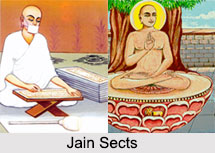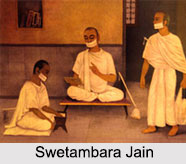 Jain order has been divided into two major sects; Swetambaras and the Digambaras. These sects have been further sub divided into several other sub-sects. The great sects of Swetambaras and Digambaras are both divided into a number of schools, orders and smaller sects. The causes of their origin and the differences between the two are quite diverse. Only a few of them owe their origin to teachers whose views were different from those which were generally acknowledged. Many came into existence purely on account of the fact that the pupils of a teacher or the monks of a place came together who felt that they belonged together as one group with respect to one another.
Jain order has been divided into two major sects; Swetambaras and the Digambaras. These sects have been further sub divided into several other sub-sects. The great sects of Swetambaras and Digambaras are both divided into a number of schools, orders and smaller sects. The causes of their origin and the differences between the two are quite diverse. Only a few of them owe their origin to teachers whose views were different from those which were generally acknowledged. Many came into existence purely on account of the fact that the pupils of a teacher or the monks of a place came together who felt that they belonged together as one group with respect to one another.
A number of Ganas "schools", Kulas "sub-classification of schools" and Sakhas "branches" are already mentioned in the Kalpasutra in which they were split. The number of Gacchas existing today is negligible.
Swetambara Sect
The Swetambara monks and nuns cover their mouth with a white cloth. They wear the cloth while talking so that they do not kill any organism in the process. They practice Ahimsa in every possible way. The Swetambaras believe that women can also attain Moksha.
Sub Sect of Swetambaras
 Swetambara sect has been split into three main sub-sects. They are:
Swetambara sect has been split into three main sub-sects. They are:
Murtipujaka: the members of this sub sect worship idols.
Sthanakvasi: The monks of Sthanakvasi cover their mouths with strips of cloth for all the time.
Terapanthi: The Terapanthi sub-sect was established by Swami Bhikkanaji Maharaj.
Digambara Sect
The Digambara sect of Jainism moves about without clothes. They believe that by discarding clothes they have been able to refuse to give in to the body"s demand for comfort. This is because they believe that nature is the best cover of the body. The Digambaras beg their food and eat only once a day.
Sub-Sects of Digambaras
The Digambara sect has been divided into Bisapantha, Terapantha and Taranapantha. They also have two minor sub sects, Gumanapantha and Totapantha.
Bisapantha: The Bisapantha followers support the Dharma-gurus, the religious authorities known as Bhattarakas.
 Terapantha: Terapantha was formed in North India in the year 1683 of the Vikram Era. It was formed to revolt against the domination of the Bhattarakas.
Terapantha: Terapantha was formed in North India in the year 1683 of the Vikram Era. It was formed to revolt against the domination of the Bhattarakas.
Taranapantha: Taranapantha was founded by Tarana Swami. The followers of this sub-sect worship "Sarnaya", the sacred books and not the idols, hence they are also known as "Samaiyapantha".
Gumanapantha: The Gumanapantha sect was started by Pandit Gumani Rama, son of Pandit Todarmal. He lived in Jaipur in Rajasthan.
Totapantha: The Totapantha sub-sect was formed because of the differences between the Bisapantha and Terapantha sub-sects.
Yapaniya Sect
Yapaniya was a Jain sect in western Karnataka which is now extinct. This sect existed in Karnataka at least from the 5th to the 14th century. According to the history, the Yapaniya worshipped nude images of the Tirthankaras in their temples. Some of these temples can still be seen and are now worshipped by the Digambaras.




















